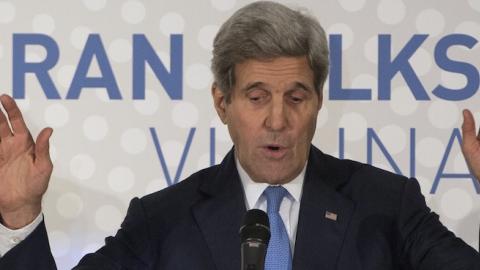As we go to press, the White House has reportedly offered Iran a deal regarding its nuclear program, a framework agreement with details to be worked out in the coming months. However, even as the interim agreement is set to expire November 24, it seems the Iranians have not responded to the Obama administration’s offer. And why would they? The White House has made it clear it wants a deal more than the Islamic Republic does. Under the circumstances, why wouldn’t Tehran wait to see how many more U.S. concessions it can extract?
There appears to be compromise on a number of major issues, like the number of centrifuges Iran will be able to keep (around 5,000). Other details, like the pace of sanctions relief and addressing the possible military dimensions of the program, seem to be where the Iranians are trying to force the administration to bend. All we know for certain is that the Obama White House is a long way from where it was a year ago, and not in a good sense.
Back then the administration told Congress not to worry about oversight—it was going to get a good deal or walk away from the table. No deal at all was better than a bad one. Last year, the slogan was “stop, shut, and ship,” which meant the Iranians would have no choice but to cease their weapons program once and for all. Now, the deal would compel the Iranians only to disconnect centrifuges, which would leave them in a position to restart activities promptly—and, without a proper verification regime, secretly.
The administration is said to be happy to have bargained Iran down to around 5,000 centrifuges—a number low enough that the international community would have approximately six months’ notice if Iran tried to break out. This assumes transparency—that Washington and its allies can accurately assess the state of Iran’s nuclear weapons program. However, the revelation over the last decade of secret Iranian facilities—at Natanz, then Fordow—is evidence that our window into Iranian nuclear activities is cloudy. It assumes further that if we could forecast a breakout, the international community would have the will to stop Iran, that it would be possible, for instance, to get a resolution through the United Nations Security Council in a timely fashion. It assumes therefore not only the acquiescence of allies, like Germany, already eager to do business with a post-sanctions Iran, but also the agreement of Russia and China, who in fact would be certain to stall, if not block, action at the U.N.
Moreover, it is worth noting that the preceding conditions are applicable only in a best-case scenario, in which the White House might really have six months to act. It is much more likely that the administration will have no margin of error—which is to say, if we are talking about activities at a clandestine facility, the breakout time will be measured not in months but in weeks.
As David Albright, founder and president of the Institute for Science and International Security, explains, one of the major issues dividing the two sides is the issue of how PMDs (the term of art for possible military dimensions) affect the verification regime. The International Atomic Energy Agency, Albright said on a conference call last week organized by the Israel Project, needs to know the history of Iran’s nuclear program. Without that, he said, “we simply cannot understand if Iran . . . has hidden parts of [a] past nuclear weapons program, perhaps even nuclear material. And so the IAEA simply cannot give the assurance that there’s not some secret part there unless they understand the history and know who did what, where it was done, and then have assurance that those people and those activities at those facilities have stopped, and they’ve not been moved someplace else.”
In other words, if Iran can already undermine the organization responsible for verifying compliance with the agreement, then it can certainly do so in the future as well. Indeed, as Albright explains, “it would be a lot easier in the future, when there are no . . . major economic and financial sanctions that can leverage Iran to cooperate.” Presumably, this is the item the Iranian side is most eager to see the White House concede: to hollow out the verification regime and thereby help Iran keep aspects of its program out of the spotlight of IAEA inspectors.
Maybe the Obama administration was simply naïve to have believed that Supreme Leader Ali Khamenei would give newly elected president Hassan Rouhani a lot of room to maneuver in nuclear talks. Perhaps the White House was arrogant to think that sanctions relief would get Rouhani, as some administration officials put it, “addicted to cash” and force him to make concessions on the nuclear program in order to revive the Iranian economy.
If it wasn’t simply naïveté and arrogance, then the White House misled the American people and their representatives in Congress as well as U.S. allies. Either way, the end result is an empowered Islamic Republic and a further crumbling of the American-brokered order in the Middle East.
The White House prides itself on the notion that its nuclear negotiations with Iran will have prevented an other-wise inevitable war. The truth is the opposite. In lifting sanctions and yielding repeatedly to an expansionist Iran, the Obama administration has brought America and its allies to this pass: Either Iran will get a nuclear bomb, or war will be the only way to stop it. Worse, the administration has increased the chances we might get both outcomes at once.
This article originally appeared in the December 1, 2014, Vol. 20, No. 12 of The Weekly Standard.




















